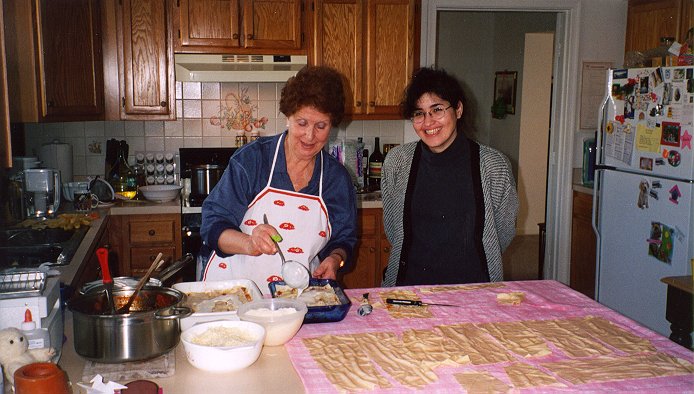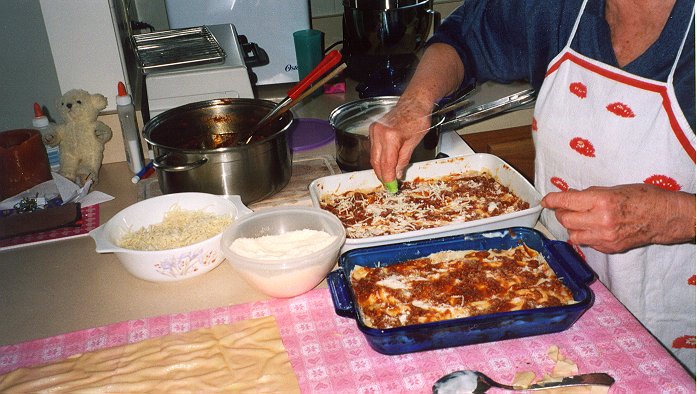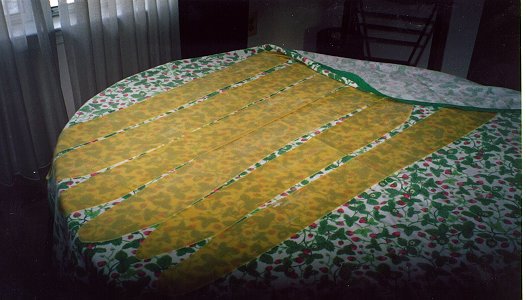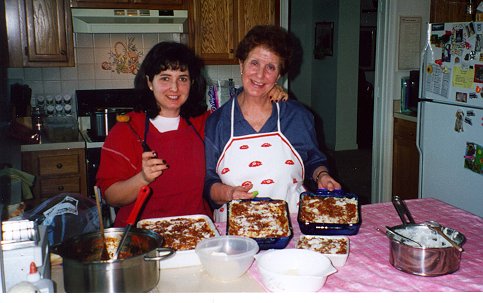
[in progress]
INGREDIENTS FOR AN 11in x 14in x 2.5in ROASTING/LASAGNA PAN
OR 12in x 18in x 3in CALPHALON ROASTING PAN
Note: 11*14 = 154, 12*18 = 216, so percentage increase about 40 percent
| 11x14 | 12x18 | in2 pan size | ||
| food process group | ||||
| 1 c | large onion | |||
| 1 c | celery | |||
| 1 c | carrots | |||
| meat saute group | ||||
| 3-4 T | olive oil | |||
| 1.4lb | lean ground beef | |||
| sauce group | ||||
| 2 c | dry white wine | |||
| 2 c | milk | |||
| 1.5 t | nutmeg | |||
| 3 28oz cans | italian plum tomatoes |
| 11x14 | 12x18 | in2 pan size | ||
| 5 c | 7 c | milk | ||
| 10.5 T = 1 stick + 2.5 T | 16 T = 2 sticks | butter | ||
| 7.5 T flour | 11 T = 2/3 c | flour | ||
| 1/3 t | 1/2 t | salt |
| 11x14 | 12x18 | in2 pan size | ||
| 5 | 7 | large eggs | ||
| 3 3/4 c | 4 1/2 c | pasta flour | ||
| or | ||||
| ? lb | ? lb | pasta sheets | ||
| [?? ?x? sheets] | [?? ?x? sheets] |
We again find the courage to face The Lasagna. By this time we have been using Marcella's new book rather frequently so we check the new version of her Bolognese sauce recipe. Surprise, it seems completely different. So we decide to fake it based on our previous experience and the license given to us by the radical change in proportions in the official recipe. Not that we carefully recorded our improvisation. Feel free to be imaginative.
We'd been hunting down a suitable big deep lasagna pan that would do justice to the real thing and finally we found an adequate solution: a 2.5 in deep 11 in x 14 in nonstick roasting pan. When we go to all this trouble, we want to make a lot of it. For this pan we decided a 6 egg pasta recipe would be needed, but it turns out that 5 would have been enough. The trick is not to boil all the noodles while assembling but to hold off till you see exactly how many you need—and then you can make fettuccine out of the rest. We had to freeze most of our boiled remnants but did catch on in time for enough fettuccine for two some night. Also frozen. Later we bought our first Calphalon pan: a bigger roasting pan, this one 12 in x 18 in x 3.5 in, for a real monster lasagna, though we got it for a turkey.
The 5 egg recipes should take about 2 hours to "work" and boil, but you have to make the dough in advance and refrigerate it in a bowl covered by a damp towel at least 1/2 hour (or the day before if you like) before this phase. The boiling is done immediately afterward. We got two 12qt stock pots 2/3 full of water boiling during the rolling phase and did 3 noodles at a time in each pot. They are done in some fraction of a minute but fishing those suckers out with a big round flat hole-filled long handled kitchen tool (what is that thing? a strainer?) and a long handled flat wooden spatula is no picnic—and not quick—so who knows how much longer than necessary we abused the noodles. They taste great anyway.
Assembly is rather quick compared to the other phases—about a half hour. We were able to do 9 layers with the amount of sauce per layer we used. Afterwards, it seemed like too much sauce compared to the noodle value. One really has to try to use the minimal amount per layer for a good result.
This takes about 4 hours minimum and is probably best done in advance (like days before). We chopped up the onion, celery, and carrots in our small food processor (since we had not yet purchased the real one). The "1 cup" quantity is only a guess. We sautéed this a while in olive oil, first the onions, and then together with the carrots and celery, but cannot see any reason why they can't all start together. As for the meat, one could probably just skip it and convert this to a vegetarian dish that would be just as good, but we haven't tried that yet. (Mushrooms are a thought.) We added 1.4 lb only because that was how much our frozen package in the freezer weighed. Less would have been fine. Throw in your choice of amount (thawed is better!) with salt and a few pepper mill twists and break apart the ground beef into its grinds (?), cooking it until no longer red. Then add the milk and simmer, stirring frequently until the milk has bubbled away (judgment call) and stir in 1/4 t nutmeg. Add the wine and simmer till it evaporates. Then add the tomatoes and stir everything up well. Once the mixture starts to boil again, turn down the heat so that the sauce barely simmers—with solitary bubbles surfacing occasionally. Cook uncovered at least 3 hours or more, stirring occasionally. When done, taste for salt and add if insufficient.
later.
Buy fresh pasta sheets. We have gotten them both at the national whole food supermarket chain and at our favorite Italian specialty store. They are still not thin enough for real lasagna, which we prefer at the last notch of the roller pasta machine setting (they are at the next to last setting), so they must be cut in about 3 in strips and passed through the roller machine to flatten out a bit (to about 4 in). Then 3 strips per layer, with lengths cut to match the pan.
[in progress]
[in progress]
[in progress]
finally gabriella shows us her technique under extenuating circumstances in the States.




amazing. Move on to our concluding remarks.